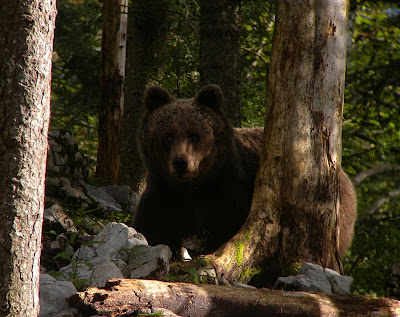 |
| Black Woodpecker Dryocopus martius - male |
 |
| Great Spotted Woodpecker Dendrocopos major - male |
 |
| Hawfinch Coccothraustes coccothraustes |
 |
| The first migrant Song Thrush Turdus philomelos |
 |
| Hyssopus officinalis - a scarce plant on the Karst, but very abundant on a dry grassland in the Glinščica/Val Rosandra nature reserve. It is a medicinal plant with a lovely smell which attracts lots of insects... |
 |
| ...the grassland was buzzing with thousands of bees |
 |
| Blue carpet |
 |
| Also good for butterflies - a Swallowtail Papilio machaon |
 |
| And good for crickets too |
 |
| Sedum album |
 |
| Amelanchier ovalis - usually blooming in May |
 |
| Daphne alpina - another odd plant in flower now (usually blooming in April/May) |
 |
| Asparagus tenuifolius with fruits |
 |
| Praying Mantis Mantis religiosa on Allium senescens/montanum |
 |
| Aster amellus |
 |
| Salvia glutinosa found on the bottom of some fresh dolines |
 |
| Beech Fagus sylvatica - on the Karst around Trieste only found as a planted tree from the 19th century - like the one above in Globoka dolina/Dolina degli Abeti. |
 |
| Mt. Nanos from mt. Vremščiča |
I've spent the last couple of days wandering the Karst (both Italy and Slovenia), mainly exploring new areas of woodland in search of good woodpecker habitat. No more luck with the Middle Spot, but I've had Black Woodpecker
Dryocopus martius almost on a daily basis and
Lesser Spotted Woodpeckers Dendrocopos minor seem to be doing well in many woodlands around the Karst (heard singing commonly). Not to mention the Great Spots
Dendrocopos major that are "infesting" in some woodlands and Green Woodpeckers
Picus viridis which are always common. Notable birds from this week included also:
Tawny Owl Strix aluco (seen at a cave's entrance),
Firecrest Regulus ignicapillus (good influx - now outnumbering Goldcrests
R. regulus), Water Pipit
Anthus spinoletta, Meadow Pipit
Anthus pratensis, Tree Pipit
Anthus trivialis, Crested Tit
Lophophanes cristatus (common, also in the garden), Whinchat
Saxicola rubetra, Stonechat
Saxicola torquatus, Wheatear
Oenanthe oenanthe,
Lesser Whitethroat Sylvia curruca (including one in the garden today), Hawfinch
Coccothraustes coccothraustes (also overflies in the garden), House Martin
Delichon urbicum (a few on passage), Swallow
Hirundo rustica (last seen on Wednesday),
Hobby Falco subbuteo, Chiffchaff
Phylloscopus collybita, Grey Wagtail
Motacilla cinerea (over the house), Coal Tit
Periparus ater (small invasions; in the garden too),
Crossbill Loxia curvirostra, Spotted Flycatcher
Muscicapa striata, Song Thrush
Turdus philomelos (first migrants, today), Mistle Thrush
Turdus viscivorus (forming autumn flocks of +30 birds), Rock
Emberiza cia & Cirl Bunting
E. cirlus and of course tons of Jays
Garrulus glandarius (all carrying their lovely acorns).
Especially wonderful was the extensive flowering carpet of
Hyssopus officinalis on mount Stena (Glinščica/Val Rosandra valley) this afternoon. Also still several species of common flowers having their last bloom before the winter... actually a sad time of year for botany lovers...
























































